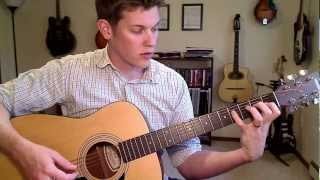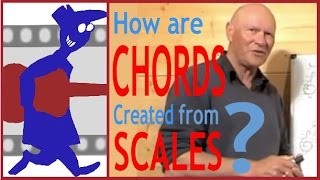How to Play the Right Strumming Pattern
Published on 26 January 2016
For more information from the source site of this video please visit: http://secretguitarteacher.com/youtube/intermediate/acoustic/3sMGGE4-Lpc/84455344-how-to-play-the-right-strumming-pattern.php
This is a sample video from the Secret Guitar Teacher website (see link above). It's from the Intermediate Acoustic Guitar Course in the Intermediate section of the site and is not for complete beginners. But if you have already learnt the basics of playing guitar and are interested in improving your strumming skills then this might be interesting for you.
Here's the abridged transcript:
How to strengthen your strumming
Over the years I think I have been asked more questions about strumming than about any other aspect of guitar playing.
People get quite anxious, I find, to be told 'the right strumming pattern' for a given song.
In this lesson we'll look at a handful of underlying patterns that form the basis of 99% of all strumming patterns used in popular music. Once you have nailed these, I think you'll find the whole subject will become a lot simpler.
So let's start with a very logical exercise. Have a look at this strumming pattern...
First, note that the strumming direction is shown by the arrows on the tab. And it is important to realise that the arrows that point Upwards are used to show Down strokes! This stems from the fact that your view of the fretboard when you play the guitar is in fact upside down
Here we have doubled the strum pattern by adding upstrokes between the down strokes. Once you are happy with that, practice shifting from one exercise to the other without losing any time. Four bars of the basic four to the bar ......followed by four bars of the 8-beat pattern.
Now that basic pattern, usually called '8-beat feel' is probably the most commonly used underlying pattern in guitar playing so it's worth spending time working on getting it smoothed out.
When you're ready to move on double up the strum pattern again like this...
This is another very commonly used pattern that we refer to as 16-beat feel.
Notice how the first strum of each beat is a long downstroke, the remaining three are short strokes played up down up.
The counting for this pattern is best vocalised as 1 e & a 2 e & a 3 e & a 4 e & a ...and so on. This helps you get the pulse of the rhythm right...
Concentrate on a smooth transition from the basic count of four-to-the-bar, through the eight-beat feel, and on up to the sixteen-beat feel. Once you are comfortable with that, I recommend practicing this transition against the metronome to help keep your timing honest.
If you don't own a metronome you can access one online from the toolbox to the right of the screen.
OK, once you are happy using the metronome try this: Start on a slow setting, say around 60 bpm... Play one strum per click-of-the -metronome like this... ...then after four bars...double it......then after another four bars double it again......then halve it...and halve it again. As you approach this level you will definitely hit physical barriers that you won't get past without improving your technique. For example, if you are using a plectrum, the exact angle you hold the plectrum will become of critical importance.
If the plectrum is perpendicular to the strings it will offer too much resistance at high speed and get caught. So you need to close the angle between the plectrum and the strings like this...
This is where a soft wrist helps, because this angle has to be reversed on the upstroke -- look at this in slow motion.. Just like painting a fence!
It also helps to make the pick travel slightly diagonally across the strings like this ...And finally, experiment with turning the pick round in your grip so that instead of using the pointed tip of the pick ...you use the rounded edge
Once you have got used to working through these three patterns in this way, you'll be well set up to cope with a wide range of songs that are written in 4/4 time. You might then like to go on to explore these patterns...
This is the basic ¾ pattern used for songs in waltz time as well as various folk-influenced tunes. Notice all the strokes are kept short in this one...
This can then be doubled like this 1&2&3& 1&2&3& These doubled patterns in ¾ are not to be confused with this pattern in 6/8 which has the same number of strokes to the bar......but has a pulse of two instead of three.
You can see that one bar of 12/8 is pretty similar to two bars of 6/8.
In practice the only difference is the pulse.6/8 has its main pulse every two main beats... 12/8 has its main pulse every four main beats...
Ok, well that's covered the underlying form behind most of the strumming patterns you are going to come across.
Some hours spent on practising these will help you build a very strong foundation to your strumming.
In the next lesson we'll look at some of the technical tricks used to make these underlying patterns more interesting.
I look forward to seeing you then.
 The Chromatic Scale
The Chromatic Scale
 Guitar Lesson: Basic Color Chords
Guitar Lesson: Basic Color Chords
 Learn Songs Faster On Guitar: How Understanding Ch...
Learn Songs Faster On Guitar: How Understanding Ch...
 Open Chords Pt 1 - G, E Minor, C add9 - Guitar Les...
Open Chords Pt 1 - G, E Minor, C add9 - Guitar Les...
 Mastering Major and Minor Pentatonic Scales
Mastering Major and Minor Pentatonic Scales
 Music Theory Made Easy - Memorize ALL Your Chords...
Music Theory Made Easy - Memorize ALL Your Chords...
 How To Play Perfect Power Chords
How To Play Perfect Power Chords
 LEARN MUSIC THEORY Easy way to write the Circle of...
LEARN MUSIC THEORY Easy way to write the Circle of...
 Creative Guitar: Harmonized Moveable Chord Shapes...
Creative Guitar: Harmonized Moveable Chord Shapes...
 How to Embellish an E Chord
How to Embellish an E Chord







